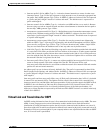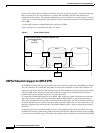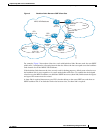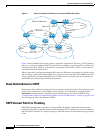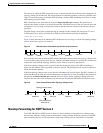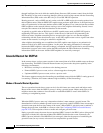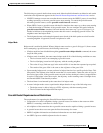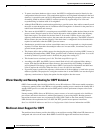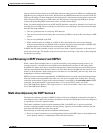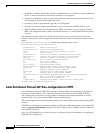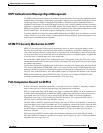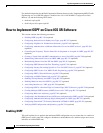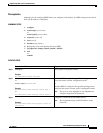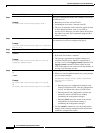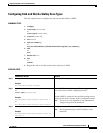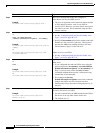
Implementing OSPF on Cisco IOS XR Software
Information About Implementing OSPF on Cisco IOS XR Software
RC-191
Cisco IOS XR Routing Configuration Guide
OL-14356-01
You can enable multicast-intact in the IGP when multicast routing protocols (PIM) are configured and
IGP shortcuts are configured on the router. IGP shortcuts are MPLS tunnels that are exposed to IGP. The
IGP routes IP traffic over these tunnels to destinations that are downstream from the egress router of the
tunnel (from an SPF perspective). PIM cannot use IGP shortcuts for propagating PIM joins, because
reverse path forwarding (RPF) cannot work across a unidirectional tunnel.
When you enable multicast-intact on an IGP, the IGP publishes a parallel or alternate set of equal-cost
next hops for use by PIM. These next hops are called mcast-intact next hops. The mcast-intact next hops
have the following attributes:
• They are guaranteed not to contain any IGP shortcuts.
• They are not used for unicast routing but are used only by PIM to look up an IPv4 next-hop to a PIM
source.
• They are not published to the FIB.
• When multicast-intact is enabled on an IGP, all IPv4 destinations that were learned through
link-state advertisements are published with a set equal-cost mcast-intact next hops to the RIB. This
attribute applies even when the native next hops have no IGP shortcuts.
In OSPF, the max-paths (number of equal-cost next hops) limit is applied separately to the native and
mcast-intact next hops. The number of equal cost mcast-intact next hops is the same as that configured
for the native next hops.
Load Balancing in OSPF Version 2 and OSPFv3
When a router learns multiple routes to a specific network by using multiple routing processes (or
routing protocols), it installs the route with the lowest administrative distance in the routing table.
Sometimes the router must select a route from among many learned by using the same routing process
with the same administrative distance. In this case, the router chooses the path with the lowest cost (or
metric) to the destination. Each routing process calculates its cost differently; the costs may need to be
manipulated to achieve load balancing.
OSPF performs load balancing automatically. If OSPF finds that it can reach a destination through more
than one interface and each path has the same cost, it installs each path in the routing table. The only
restriction on the number of paths to the same destination is controlled by the maximum-paths (OSPF)
command. The default number of maximum paths is 32 for Cisco CRS-1 routers and 16 for
Cisco XR 12000 Series Routers. The range is from 1 to 32 for Cisco CRS-1 routers and 1 to 16 for
Cisco XR 12000 Series Routers.
Multi-Area Adjacency for OSPF Version 2
The multi-area adjacency feature for OSPFv2 allows a link to be configured on the primary interface in
more than one area so that the link could be considered as an intra-area link in those areas and configured
as a preference over more expensive paths.
This feature establishes a point-to-point unnumbered link in an OSPF area. A point-to-point link
provides a topological path for that area, and the primary adjacency uses the link to advertise the link
consistent with draft-ietf-ospf-multi-area-adj-06.
The following are multi-area interface attributes and limitations:
• Exists as a logical construct over an existing primary interface for OSPF; however, the neighbor state
on the primary interface is independent of the multi-area interface.



